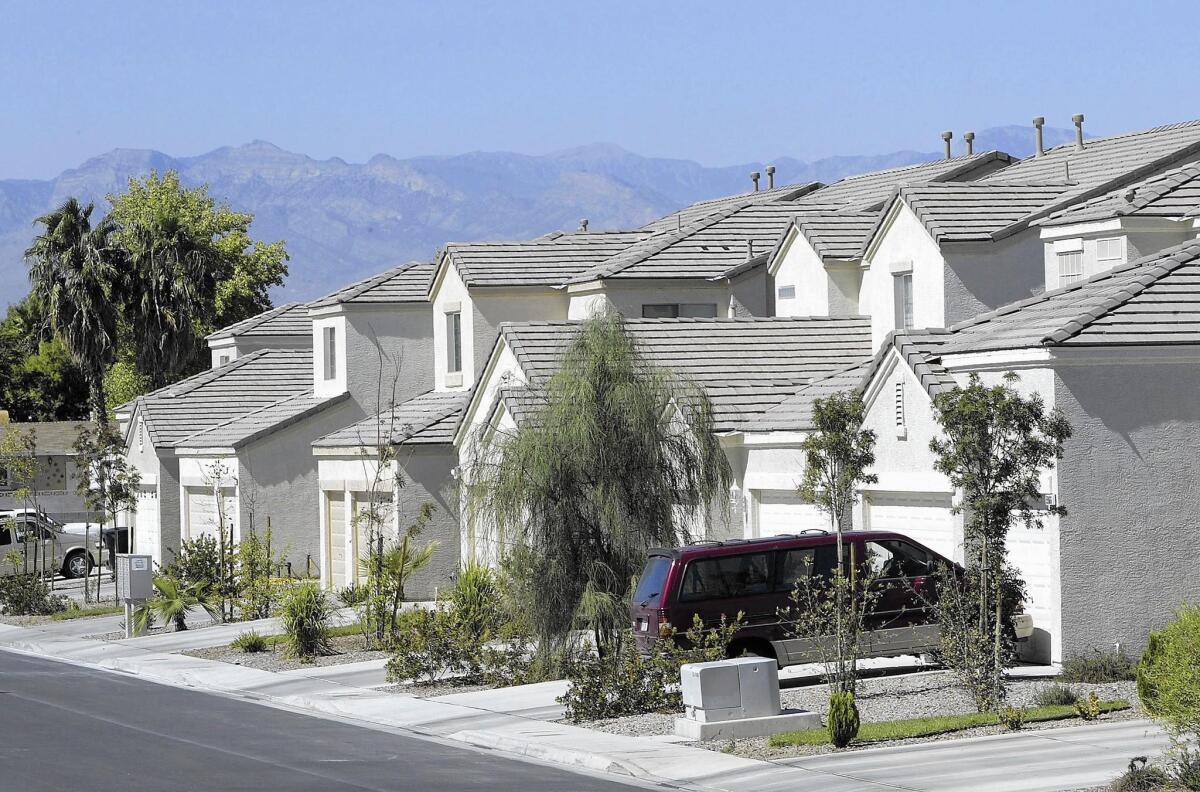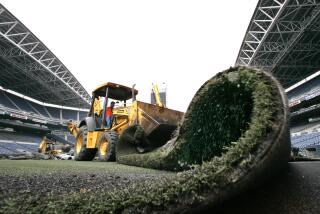Amid drought, the West is no place for a lawn, as Nevada has learned

In Las Vegas, the traditional American front lawn has largely given way to desert-compatible landscaping, as seen here in 2004.
- Share via
Reporting from LAS VEGAS — When Gov. Jerry Brown ordered that California rip up 50 million square feet of lawns to conserve water amid the West’s deadening drought, the Golden State gasped.
Meanwhile, the Silver State yawned.
Desert denizens have already been there and done that — since 1999, in fact.
A near-continuous population boom has long driven officials here to seek water-saving solutions to slake the region’s thirst. Using community outreach and cash incentives, the area’s Water Smart Landscaping Program has removed nearly 4,000 acres — 173 million square feet — of lawn space.
That’s enough to cover nearly 3,000 football fields, or stretch an 18-inch-wide strip of backyard sod almost entirely around the planet.
Across the West, a chronic water shortage may yield what was once unthinkable: The American lawn, that domestic decoration greening the nation’s suburban tracts, could become an ornament of the past, at least this side of the Rockies.
But changing the landscaping means changing the mind-set.
“Looking at the lawn in the context of the drought, what was ridiculous has become indefensible,” said author Michael Pollan, who has written about his boyhood experiences with the family lawn. “It’s a wasteful way of treating the land.”
He tore up the front lawn of his Berkeley home in 2006, replacing it with a vegetable garden.
“They’re absolutely absurd, but we love them,” Pollan said. “In the arid West, we will one day look back on lawns like we now do littering, smoking in bars and public urination.”
In southern Nevada, this has been a hard sell. Many natives insisted they were entitled to their lawns, drought be damned. Transplants wanted to keep a grassy aesthetic they’d grown up with in Chicago or Charlottesville.
“We reminded everyone they live in the Mojave Desert,” said Bronson Mack, a spokesman for the Southern Nevada Water Authority, an umbrella group comprising seven water agencies. “We had to find a way to make them rethink the best use of grass in an arid environment.”
After years of gentle prodding that included common-sense community seminars on water-saving tips, many Las Vegas lawns have now morphed into environmentally sustainable spaces with desert landscaping. “In the long run, many homeowners realized they weren’t really using the grass until they pushed a lawn mower across it,” Mack said.
Even before Brown’s order, some of California’s 411 water districts offered rebates -- now as much as $3.75 per square foot -- to persuade homeowners to give up on grass.
The Southern Nevada Water Authority pays $1.50 per square foot of lawn replaced with desert landscaping, up to 5,000 square feet. After that, it’s $1 per square foot. Arizona and Utah also have lawn rebate programs.
The message: Don’t “feed it!” as the TV lawn-care pitchman purrs in his Scottish brogue. Replace it. Or at least downsize it.
“You don’t need wall-to-wall carpeting if an area rug will do,” Mack said.
Las Vegas has become an unlikely water-saving mentor — visited by fact-finding groups from South Korea, Israel and neighboring California.
“We went to Las Vegas before we started our program,” said Penny Falcon, water conservation policy manager at the Los Angeles Department of Water and Power, which has pushed lawn makeovers since 2009. “What they were doing just made sense.”
In addition to paying rebates, the Southern Nevada Water Authority sponsors landscaping contests and offers homeowners free, downloadable designs, divvied into categories, such as “pool-friendly” and “child-friendly.”
Las Vegas officials say they have removed nearly 4,000 acres of grass, with plans to rip up 3,000 more. In Los Angeles, officials want to take out 25 million square feet of grass by year’s end.
But there’s push-back from the $25-billion-a-year grass industry, which says lawns are good for the environment, producing oxygen, preventing soil erosion and dissipating heat.
“Kids play on lawns, dogs walk on them, you can lay down there in the summer and read a book,” said Jim King, a spokesman for the Miracle-Gro company. “We believe there is a future for lawns in the western U.S. They’re just going to look a little different.”
Miracle-Gro officials and others met with Brown recently to discuss conservation steps, King said. Experts say too many homeowners wastefully over-water their grass. Still, there has been progress.
“A decade ago, it was all about having the best lawn on the block,” King said. “Now people know a lawn doesn’t have to be weed-free. It doesn’t have to be the greenest or the thickest. People let their lawns go brown in the dormant season without worrying it’s going to die.”
Turf-grass sod has been around for eons: Grass allowed native hunters to stalk their prey on the African savannas. In medieval Europe, low-growing perennial turf grasses filled spaces around castles, helping watchmen scan the horizon.
Lawns appeared in European Renaissance paintings from the 15th century, before the concept was brought to North America by the first settlers. The poet William Wordsworth once called turf grass “a carpet all alive.”
The mechanical first lawn mower was invented by Edwin Beard Budding in 1830. Decades later, mass production made mowers affordable to the masses, making grass an essential part of the American domestic landscape. Today, 80% of U.S. homes have lawns, industry officials say.
But they’re not the right landscaping for all of America, critics say.
“Lawns should have never come west of the Rocky Mountains,” said Diana Balmori, a New York-based landscape architect and author of “Redesigning the American Lawn.”
The average rainfall in New York City, she said, is about 50 inches a year, compared with 15 inches in Los Angeles. Meanwhile, in places like Las Vegas, which receives less than 5 inches annually, a single square foot of lawn requires 55 gallons of water each year.
“We have to learn to fit into our place on Earth,” Balmori said. “To take green grass and apply it worldwide does not work.”
It didn’t work for North Las Vegas homeowner Ron Newsome, so he installed what he calls “the carpet.”
“No one can believe I could have grass like this in the middle of the desert,” said the 53-year-old Chicago transplant. “You can’t tell it’s not real until you get real close.”
Newsome did the work himself, spending $2,200. He soon received a $900 cash rebate. He now uses 8,000 gallons of water per month, rather than 26,000.
Best of all, he said, is foiling “the neighborhood Houdinis” — the unleashed dogs that used his lawn as a public toilet. They don’t like the faux grass.
“They take a sniff and move on,” he said. “They do their business elsewhere.”
Twitter: @jglionna
Emergency 25% cut in California cities’ water use is approved
Millions of trees dying in California, many in Sierra Nevada
More to Read
Sign up for Essential California
The most important California stories and recommendations in your inbox every morning.
You may occasionally receive promotional content from the Los Angeles Times.











